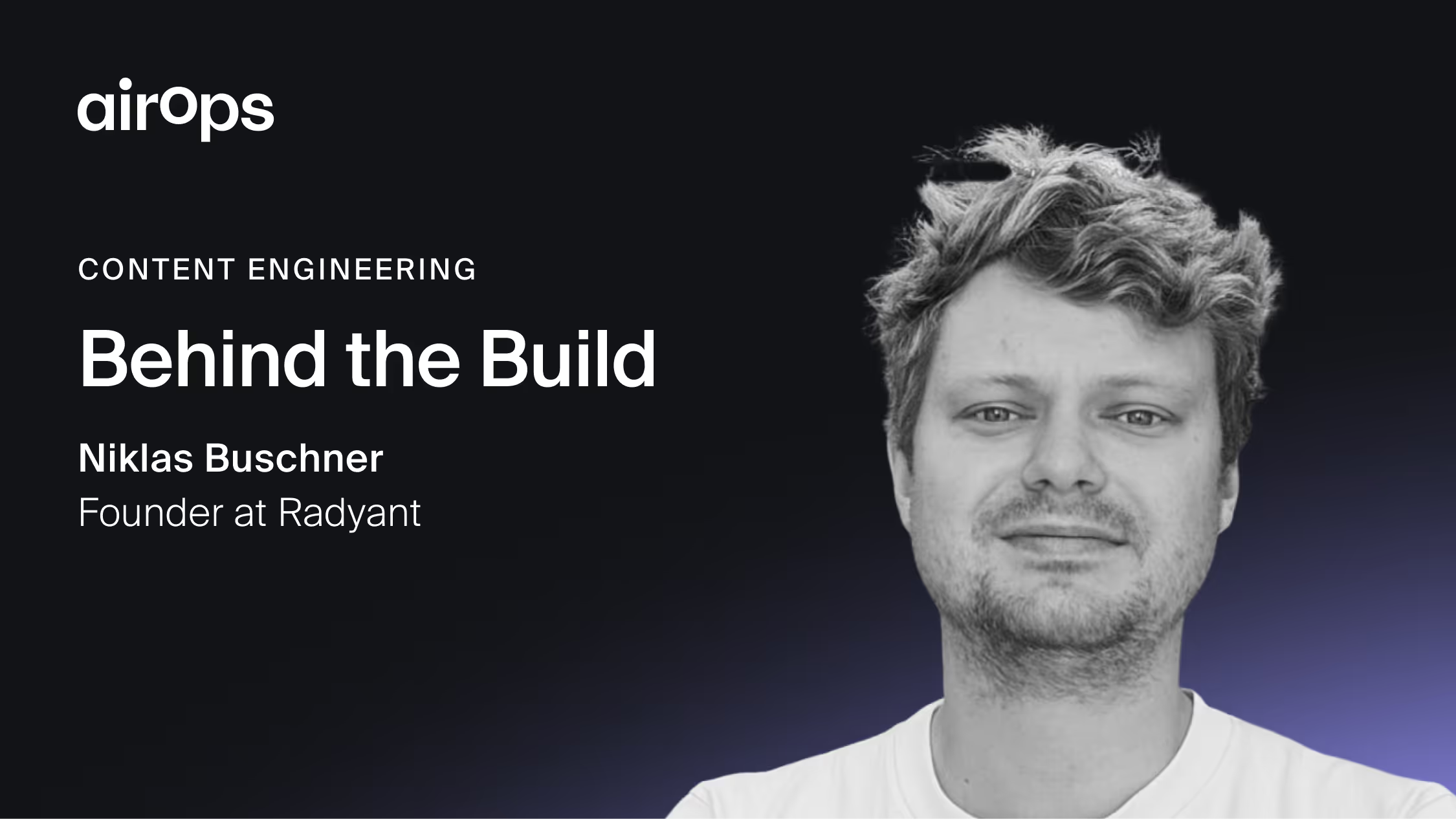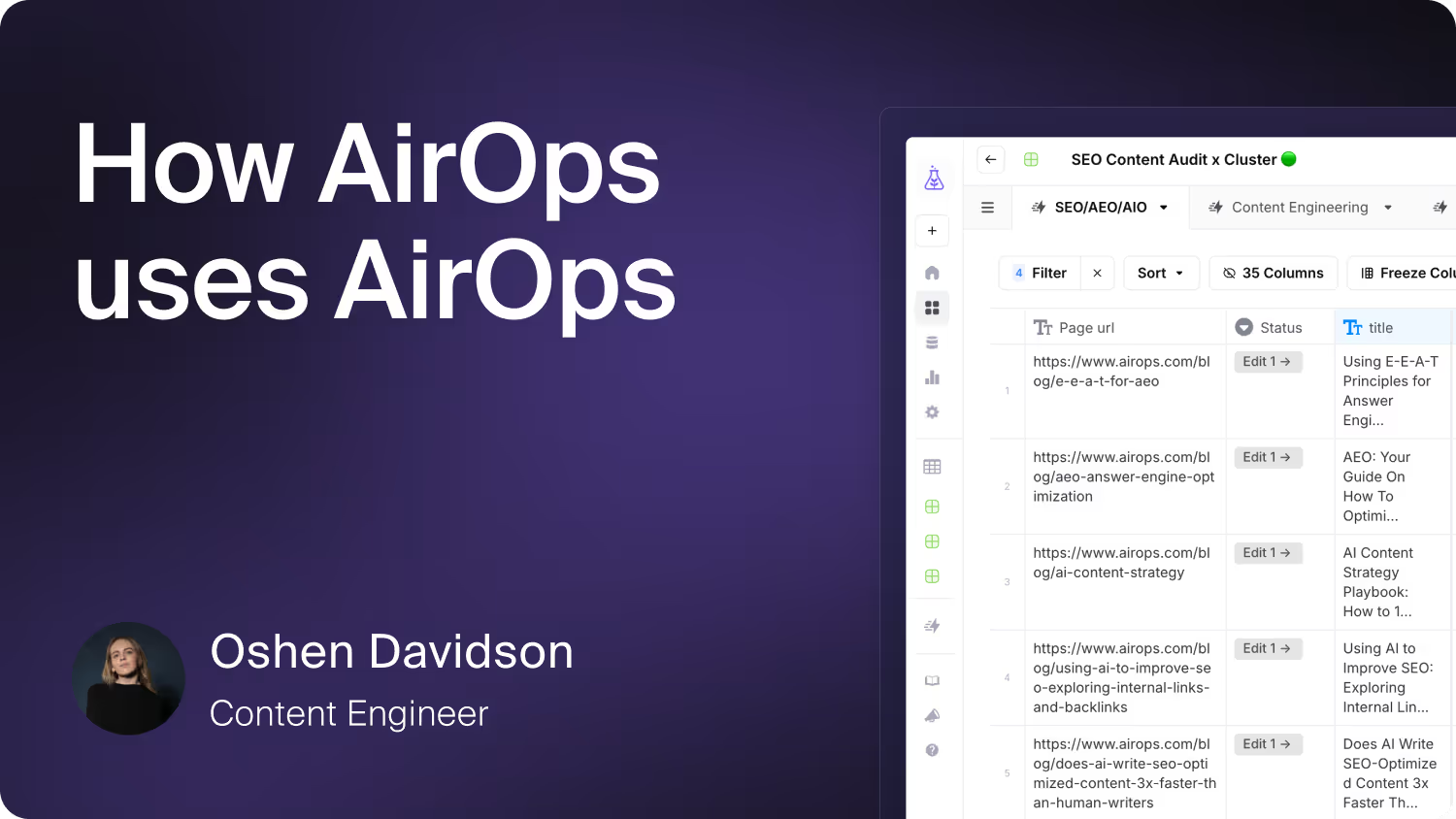Link Optimization: How to Use AI to Improve Internal and External Linking

AI simplifies link optimization by automating internal audits, anchor text refinement, and backlink discovery at scale.
LLMs and vector models improve SEO and AEO by identifying semantically relevant link opportunities that boost crawlability, authority, and extractability.
Discover how to use AI tools to enhance internal structure, build high-quality backlinks, and future-proof your content for both search engines and answer engines.
Search engines—and the way people interact with them—are changing. As AI Overviews and LLM-powered platforms like ChatGPT and Perplexity reshape search behavior, the way we build and optimize links must evolve too.
Internal links structure your content and guide crawlability. Backlinks signal authority and credibility. But managing both at scale has traditionally been manual, time-consuming, and inconsistent.
AI tools can automate and enhance every part of your linking strategy—from identifying semantic connections to rewriting anchor text and scaling backlink outreach with LLMs and vector search.
What is AI-Powered Link Optimization?
AI-powered link optimization refers to the use of artificial intelligence tools and language models to analyze, generate, and manage internal and external links across digital content.
These tools automate tasks like auditing link structure, identifying contextual linking opportunities, rewriting anchor text, and discovering backlink prospects.
Unlike traditional linking methods that rely on manual analysis or static keyword matching, AI models use techniques such as:
- Natural language processing (NLP) to understand semantic relevance between pages
- Embeddings and vector databases to recommend links based on topic similarity, not just keyword overlap
- Autonomous agents to scale outreach and backlink acquisition
This approach improves both internal linking by enhancing crawlability and content discoverability and external linking by boosting authority and trust signals through strategic citations.
Why AI Improves SEO Linking Performance
AI improves linking performance by automating time-intensive tasks, uncovering semantic relationships, and scaling efforts across large content libraries. This applies to both internal and external linking strategies:
Benefits of Internal Linking
Enhances crawlability and indexation
AI tools help identify orphaned pages and poor internal link structures, which can prevent important content from being crawled and ranked. According to Google Search Central, internal links are critical for guiding crawlers through your site and influencing which pages are indexed.
Distributes PageRank effectively
Smart internal linking ensures link equity flows to high-value pages based on site hierarchy. Google’s John Mueller has emphasized that internal linking is one of the most important aspects of SEO because it helps define site structure and page relevance.
Strengthens semantic topic clusters
AI models use embeddings and natural language processing (NLP) to surface related content—even when pages don’t share exact-match keywords. This supports stronger topic clusters, improves contextual relevance, and aligns with how search engines and LLMs evaluate meaning.
Benefits of External Linking
While internal links shape how search engines crawl and understand your site, external links influence how authoritative and trustworthy your content appears. AI tools enhance both strategies in distinct but complementary ways.
Increases authority and trust signals
Linking to credible, high-authority sources—such as academic publications, government websites, or industry leaders—strengthens your content’s trustworthiness. According to Google’s Search Quality Evaluator Guidelines, high-quality external links help establish expertise, authoritativeness, and trust (E-E-A-T).
Supports Answer Engine visibility
External links to reputable domains make your content more verifiable and useful to large language models like ChatGPT, Claude, and Perplexity. Research from Screpy notes that outbound links to trusted sources increase the likelihood of being cited in LLM-generated responses.
Keeps content current and credible
AI tools can monitor existing outbound links to detect broken, outdated, or low-authority references—and recommend stronger alternatives in real time. This ensures your content remains accurate, up-to-date, and aligned with Google’s emphasis on helpful, reliable information.
How to Use AI to Improve Internal Linking
1. Audit Internal Links with AI
A thorough internal link audit reveals structural issues that hinder SEO performance—such as orphaned pages, uneven PageRank distribution, or excessive linking on low-priority content. AI automates this process with greater speed, scale, and semantic precision than manual methods.
AI-powered audits use site crawling, natural language processing (NLP), and embeddings to identify optimization opportunities that traditional tools often miss.
What to Analyze with AI:
- Orphaned or underlinked pages: Pages with no internal links pointing to them are invisible to search engines unless directly listed in the sitemap. AI crawlers or vector-based site graphs help surface these hidden pages.
- Overlinked pages or paragraphs: Pages with excessive links—especially within dense paragraphs—can dilute link equity and overwhelm users. Leverage AI to identify if pages or paragraphs are overlinked.
- Inefficient link distribution: AI models analyze PageRank flow and topical depth to suggest where internal links are missing across content clusters.
Recommended Tools and Workflows:
- Screaming Frog + OpenAI plugin: Crawl your site and export linking data to feed into a GPT model for interpretation and prioritization.
- AirOps internal linking workflow: Use AirOps LLM-powered semantic search to identify internal link gaps and optimize anchor text across pages.
- Custom embedding pipelines (e.g., OpenAI + Pinecone): Map your entire content corpus into a vector space to analyze semantic relationships and uncover missed links.
2. Identify Internal Linking Opportunities
Manual internal linking often overlooks contextually relevant connections—especially when writers aren’t sure how to add links into content in a way that supports both structure and user experience.
AI models trained on semantic meaning can detect deeper relationships between pages, helping you build more complete topic clusters and improve internal navigation. This allows AI to suggest internal links based on semantic similarity, not just exact-match terms.
Key AI capabilities for internal link suggestions:
- Semantic matching using embeddings: AI identifies contextually related content—even when titles or headings differ—by analyzing meaning rather than surface-level text.
- Topic clustering: Embedding-based clustering groups similar pages by theme or intent, helping you identify internal link opportunities within content hubs.
- Intent-aware link matching: LLMs analyze the purpose of a section (e.g., informational, how-to, navigational) and match it with the most relevant destination page.
- Anchor text generation: AI recommends descriptive, semantically aligned anchor text based on the source paragraph and the linked content’s topic.
According to Google’s guidance on site structure, well-structured internal links help search engines understand content relationships and rank pages more effectively.
When implementing AI-powered internal linking, consider the optimal number of internal links per page to balance SEO value and user experience.
3. Optimize Anchor Text with AI
Anchor text plays a critical role in helping both search engines and users understand the relationship between two pages. Vague or repetitive phrases like “click here” or “read more” weaken SEO performance and make it harder for LLMs to interpret context. AI tools can evaluate, rewrite, and improve anchor text at scale using semantic understanding.
How AI enhances anchor text optimization:
- Detects vague or generic anchors: LLMs scan content to identify common weak patterns and flag them for refinement.
- Suggests semantically rich alternatives: Based on the source content and the target page’s topic, AI recommends anchor phrases that clearly convey relevance and intent.
- Aligns with search intent: AI-generated anchor text can be tailored to match specific intent types—informational, transactional, or navigational—improving alignment with user needs and SERP performance.
- Improves LLM citation potential: Clear, descriptive anchor text increases the likelihood that your content is cited by AI tools and answer engines, which prefer extractable relationships between linked concepts.
AEO Tip: Avoid over-optimization by using natural, varied phrases. AI tools can help rotate anchors intelligently while maintaining semantic clarity—especially when paired with internal linking best practices that prioritize user experience and crawl efficiency
Example workflow: Use a GPT-based model to review all anchor text on a page, classify intent (e.g., navigational vs. informational), and generate improved variants. Tools like AirOps or custom GPT+embedding setups can do this at scale across your content.
Automate Internal Link Insertion with AI
Manually adding internal links across dozens—or hundreds—of articles is time-consuming and error-prone. AI tools can streamline this process by automatically suggesting, placing, and even inserting links during the drafting or publishing process.
How AI enables automated link placement:
- Dynamic link suggestions: LLMs can scan in-progress drafts or existing pages and recommend relevant internal links based on semantic similarity and topic clusters.
- Anchor placement within paragraphs: AI identifies natural language anchors (e.g., noun phrases or topic entities) and inserts links in context, preserving readability.
- CMS and workflow integration: AI models can plug into your content management system (CMS), using pre-indexed embeddings or memory stores to recommend or auto-insert links as part of your publishing workflow.
- Scalable implementation: Internal links can be batch-inserted across your content library using structured automation workflows.
Daisie, a social and education platform, used AirOps to automatically link its course catalog to generated articles. This strategy helped Daisie achieve a 60X increase in traffic.
According to Google Search Central, internal links help define site structure and clarify which pages are most important—making automated, intent-aligned linking a scalable SEO asset.
How to Use AI to Improve External Links and Backlink Building
1. Discover Backlink Opportunities with AI
Backlinks remain one of Google’s strongest ranking factors—and they also influence visibility in AI Overviews and other answer engines.
Pages that earn links from trusted domains are more likely to appear in generative search results and be cited in LLM-driven summaries.
AI tools streamline backlink discovery by identifying high-quality, semantically aligned opportunities that support both traditional SEO and AEO strategies.
How AI improves backlink discovery:
- Competitor backlink analysis: Use AI to summarize backlink profiles from tools like Ahrefs or Semrush, identifying high-authority domains that link to your competitors but not to you. This helps uncover missed opportunities in your niche.
- Unlinked brand mention detection: AI can monitor the web for brand or product mentions that don’t include a link. These are high-conversion outreach targets that boost both search rankings and AI Overview visibility when linked.
- Topical relevance matching via embeddings: AI-powered embeddings match your content to external sites that cover similar subjects—even when phrasing differs. This helps you prioritize backlinks from thematically aligned, contextually relevant sources, which are favored by LLMs.
- Authority scoring and prioritization: LLMs can sort link prospects by metrics like Domain Authority or E-E-A-T signals. This enables your team to focus on acquiring backlinks from domains most likely to pass value and be recognized by answer engines.
According to research from Screpy, outbound and inbound links to reputable domains increase your likelihood of being cited in ChatGPT and Perplexity responses.
AEO Tip: Backlinks from trusted domains not only improve PageRank but also increase the chances your content is referenced directly in AI Overviews. LLMs favor pages that cite credible sources and are themselves cited across the web.
2. Automate Backlink Outreach with AI
Securing high-quality backlinks at scale requires outreach—but manual prospecting, writing, and follow-ups are time-consuming and often inconsistent.
AI transforms this process by automating research, personalizing pitches, and increasing your chances of earning backlinks from authoritative, LLM-recognized domains.
How AI powers scalable outreach:
- Contact discovery and email extraction: AI agents can crawl target sites, extract contact information, and structure outreach lists automatically—eliminating hours of manual research.
- Personalized pitch generation: LLMs can write tailored outreach emails based on the recipient’s role, past content, or site focus. AI can adapt tone and structure to match editorial guidelines or previous successful campaigns.
- HARO and journalist response automation: AI tools can monitor Help a Reporter Out (HARO) and similar PR platforms, classify opportunities by topic relevance, and draft expert responses aligned with your brand voice.
- Follow-up sequencing: Autonomous AI agents can schedule and send follow-up emails, track replies, and escalate leads—creating an automated backlink acquisition pipeline.
According to Backlinko’s study, personalized outreach emails have a significantly higher success rate than generic pitches—something AI can now deliver at scale.
3. Maintain and Optimize Outbound Links with AI
Outbound links—when chosen thoughtfully—can enhance your content’s credibility, improve user experience, and increase your chances of being cited by AI systems.
But over time, external links can become outdated, broken, or irrelevant. AI helps monitor and refresh outbound links at scale to preserve trust signals and improve extractability for answer engines.
How AI improves outbound link quality:
- Broken link detection and replacement: AI agents can continuously crawl your published content and identify broken or redirected outbound links. Once flagged, LLMs can suggest more current, authoritative replacements based on content similarity and domain authority.
- Low-authority link identification: AI models can evaluate outbound link domains for E-E-A-T relevance and authority. If a linked source no longer meets credibility standards, AI can recommend a better alternative—especially from domains favored by LLMs and answer engines.
- Context-aware source updates: When an outbound link points to outdated stats or publications, LLMs can suggest newer research or more recent sources that align with the original citation’s intent, improving both accuracy and topical freshness.
- Automated metadata and citation formatting: AI can standardize how outbound citations are presented (e.g., author, date, title), making them more extractable for LLMs parsing structured content.
According to Google’s Search Quality Evaluator Guidelines, high-quality sources and well-maintained outbound links are a core component of assessing a page’s trustworthiness.
What types of links are most valuable for LLM visibility?
LLMs like ChatGPT and Perplexity prioritize content that cites recent, authoritative, and semantically relevant sources. Outbound links to government sites, academic institutions, research publications, and trusted media outlets improve a page’s credibility and increase its chances of being cited in AI-generated answers. Clear anchor text and consistent formatting also improve extractability.
Does AI help content rank better by building backlinks?
AI doesn’t guarantee rankings, but it accelerates the outreach process, identifies high-authority domains, and personalizes pitches—improving your chances of earning backlinks that boost both SEO and credibility in LLM-based search engines.
AI Makes Linking Smarter, Scalable, and Search-Ready
Internal and external linking are foundational to SEO—but in the age of AI Overviews and answer engines, they’re also critical for visibility, extractability, and authority in LLM-driven search. Manually managing links across a growing content library is inefficient and error-prone. AI changes that.
By using AI tools like LLMs, embeddings, and automation workflows, you can:
- Strengthen site structure with smarter internal links
- Build authority through high-impact backlinks
- Keep outbound citations current, trusted, and LLM-friendly
Whether you’re optimizing for SEO or aiming to be cited in ChatGPT, an AI-powered linking strategy is now essential to stay competitive and visible.
How AirOps Can Help With AI-Powered Internal Linking and Backlink Building Workflows
AirOps gives you the infrastructure to automate link optimization across your content operation—from internal semantic linking to AI-driven backlink outreach.
With AirOps, you can:
- Create and search knowledge bases to discover and insert relevant internal links across thousands of pages
- Automate anchor text rewriting with workflows trained on your brand voice and intent
- Automate backlink outreach using LLM-powered workflows customized to your audience and niche
- Conduct deep research using LLMs to uncover statistics, trends, and expert insights—making your content more authoritative, linkable, and extractable for AI Overviews
- Keep outbound links accurate and LLM-friendly with AI-based monitoring and replacements
AirOps turns linking from a manual task into a scalable growth lever—built for both search engines and answer engines.
Want to future-proof your linking strategy? Book a demo with AirOps to learn how our AI workflows can improve your site’s authority, visibility, and performance.
Win AI Search.
Increase brand visibility across AI search and Google with the only platform taking you from insights to action.
Get the latest on AI content & marketing
Get the latest in growth and AI workflows delivered to your inbox each week
.avif)





